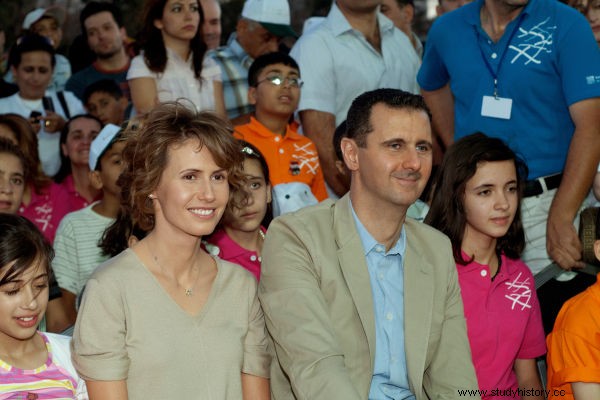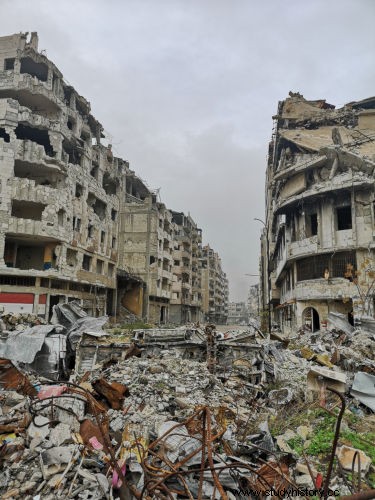The War Civil Syria, conflict that has been going on since 2011, was started by the Arab Spring protests. The violent reaction of Bashar al-Assad's government led to the emergence of an armed opposition. It is estimated that, to date, around 600,000 people have died as victims of this conflict .
Read more :The terrorist attacks that shocked the United States at the beginning of the 21st century
Causes of the Syrian Civil War
The civil war in Syria is an offshoot of the protests that took place in the country since the Arab Spring , which arrived in Syria in January 2011. The Arab Spring is the name given to the popular protests that shook North Africa and the Middle East in late 2010 and early 2011.

Syria is ruled dictatorially by Bashar al- Assad since 2000 and by the al-Assad family since the 1970s. The protests in Syria against the government of Bashar al-Assad they were motivated by the wave of demonstrations that spread through the Arab countries and brought to the surface the population's dissatisfaction with the way the al-Assad family governs the country.
The first protests took place in Deraa, a city in southern Syria, and there a symbolic event mobilized the country against Bashar al-Assad. In March 2011, students were arrested after carrying out a graffiti against the country's president with a message announcing that he would be the next ruler to fall.
The government's response was to mobilize Syria's secret police to arrest the students, who were taken for interrogation, where they were tortured. The case shocked the country and mobilized more people to protest against Bashar al-Assad. Thus, large protests were held in important cities such as Damascus and Aleppo.
Protesters called for government reforms, democratic improvements, the institution of multi-partyism, more jobs, better living conditions, etc. The government's reaction was violent, and police forces were used to suppress Protestants. The government's repression motivated the population to organize new protests, which spread across the country and continued to be repressed.
The war began when groups of civilians active in the protests joined forces with the defecting military and formed armed militias. These militias aimed to fight back against government violence and drive Syrian army troops out of their cities. Bashar al-Assad's response was to impose more repression, and so the violence spread throughout the country.
Login also :Gulf War, the fight against Saddam Hussein
Growth of the Syrian Civil War
The civil war in Syria initially mobilized the opposition represented by the Free Syrian Army (FLA) against Syrian government troops. The ELS emerged through the mobilization of civilians during the Arab Spring protests. By joining forces with deserters, this armed group was formed and became official in July 2011.
ELS was considered to be a group of secular origin, that is, one that was not linked to any religious tendency and therefore represented the moderate wing of the opposition. This position of the ELS changed radically over the course of the conflict, as the secular origin was abandoned and the group adhered to ideals of religious fundamentalism.
In addition, the combat focus of the ELS has been radically transformed. At the beginning of the civil war in Syria, their main objective was to overthrow the government of Bashar al-Assad and establish a democratic government. Over the years, ELS has become combat-focused a the Kurds in northern Syria , on the grounds that they wanted to fragment Syrian territory. This struggle by the FSA against the Kurds is a reflection of the support that the FSA receives from Turkey in this conflict.
As the war progressed, other rebel groups emerged , many of extreme orientation. The largest of these extremist rebel groups is the Sunni-oriented Hayat Tahrir al-Sham, formerly known as the Sunni-oriented Fateh al-Sham Front and Al-Nusra Front. This group, until July 2016, was al-Qaeda's armed wing in Syria.
Hayat Tahrir al-Sham's detachment from Al-Qaeda — it is believed — would have taken place peacefully. However, we know that this is not true, because, some time later, Hayat Tahrir al-Sham came into conflict with Hurras al-Din, a fundamentalist group that emerged in February 2018 and is considered the current representative of Al-Qaeda in the Syria.
Starting in 2014, taking advantage of Syria's fragility, the former Iraqi branch of Al-Qaeda, known as the Islamic State (IS), invaded the country and conquered part of the territory. . The actions of the Islamic State led to the founding of a caliphate in the region. Caliphate is a kind of Islamic kingdom that enforces sharia (Islamic law).
The Islamic State seeks va full autonomy over Syria and, therefore, he was the enemy of all the forces that were fighting in the country. This terrorist organization was a real threat to the government of Bashar al-Assad and to other groups in Syria, which led to a large internal and international mobilization against the advance of this organization .
Countries like Russia and the United States have mobilized huge resources to fight the Islamic State, as has the Syrian government. Rebel groups such as the Free Syrian Army have also fought the Islamic State. The mobilization against IS has paid off and currently he no longer controls territories in Syria, although he is still seen as a threat for his international performance.
The violence brought on by the Islamic State prompted Syrian Kurds to mobilize in self-defense. Thus, the Syrian Kurdistan People's Protection Unit was born. The YPG (Kurdish acronym) belongs to Syrian Kurdistan, an area of northern and northeastern Syria that is under Kurdish control. The region is also known as the Democratic Federation of Northern Syria.
The Kurds are accused of defending separatism , but they deny this and, to date, have not taken any separatist action. The YPG, which guaranteed the protection of Kurds against the Islamic State, also defends Syrian Kurds from attacks by Turkish troops. The Turks denounce the Kurds of being part of a terrorist organization.
International observers see the attacks on Kurds from the Turks as part of Turkey's strategy. Turks fear that the strengthening of Kurds in Syria will have repercussions on the Kurdish minority that inhabit Turkish territory. The Turks have reinforced their attack s after the United States withdrew its support for the Kurds in 2019.
Foreign mobilization in the Syrian Civil War

Foreign mobilization in the war in Syria happens directly and indirect, as several countries support different groups . The American mobilization, at first, took place against the Islamic State. At that time, the United States was bombing positions controlled by the extremist group to weaken it.
The United States too provides ram support for rebel groups , such as the Free Syrian Army and the People's Protection Unit. However, in the course of the conflict, the Americans withdrew their support for the FSA, which allied with the Turks; and the YPG, which allied with the Syrian government and Russia to avoid being massacred by the Turks, who intensified their attacks against the Kurds in 2019.
Russia, in turn, guarantees support for the government of Bashar al-Assad and, so far, that Syria does not suffer international sanctions. In addition, Russia joined the conflict from 2015 onwards to reinforce the Syrian government's fight against the Islamic State and the rebels. The support given by Russia was instrumental in sustaining Bashar al-Assad in power at a delicate moment.
Iran also supports the Syrian government , mainly to prevent Sunni militias from taking power in Syria, since, if that happened, Iranian interests in the Middle East would be severely threatened, as Syria would become a threat to Hezbollah, a Shiite organization based in Lebanon, neighbor of Syria. Iran sends troops, weapons and money to Bashar al-Assad.
Login also :How did Islam come about?
What were the impacts of the Syrian Civil War?
The Syrian Civil War tin more than 10 years of duration , and the extent of this conflict has left the country in ruins. The country's basic infrastructure, such as roads, hospital network, schools, among others, was destroyed. This directly affects the economy and the quality of life of the Syrian population. Millions of people were left without access to a healthcare system and millions of children dropped out of school, jeopardizing their future.
In addition to material destruction, it is important to mention impoverishment da population , who, in a war-torn country, saw his living situation deteriorate further and further. In addition, more than half of the country's population today depends on humanitarian aid to survive, as basic items for survival, such as food, are in short supply.
The war also caused thousands of dead and it is said that by the end of 2020, almost 600,000 people have died. In addition, another 13 million people abandoned their homes to ensure their survival. More than half of them migrated from the region in Syria itself, and more than 5 million people fled the country.
It is not known when the war will end , since foreign interventions continue to fuel the conflict. Furthermore, none of the sides involved seem willing to lay down arms, which leaves Syria with its future very threatened.
Image credits :
[1] John Wreford and Shutterstock
